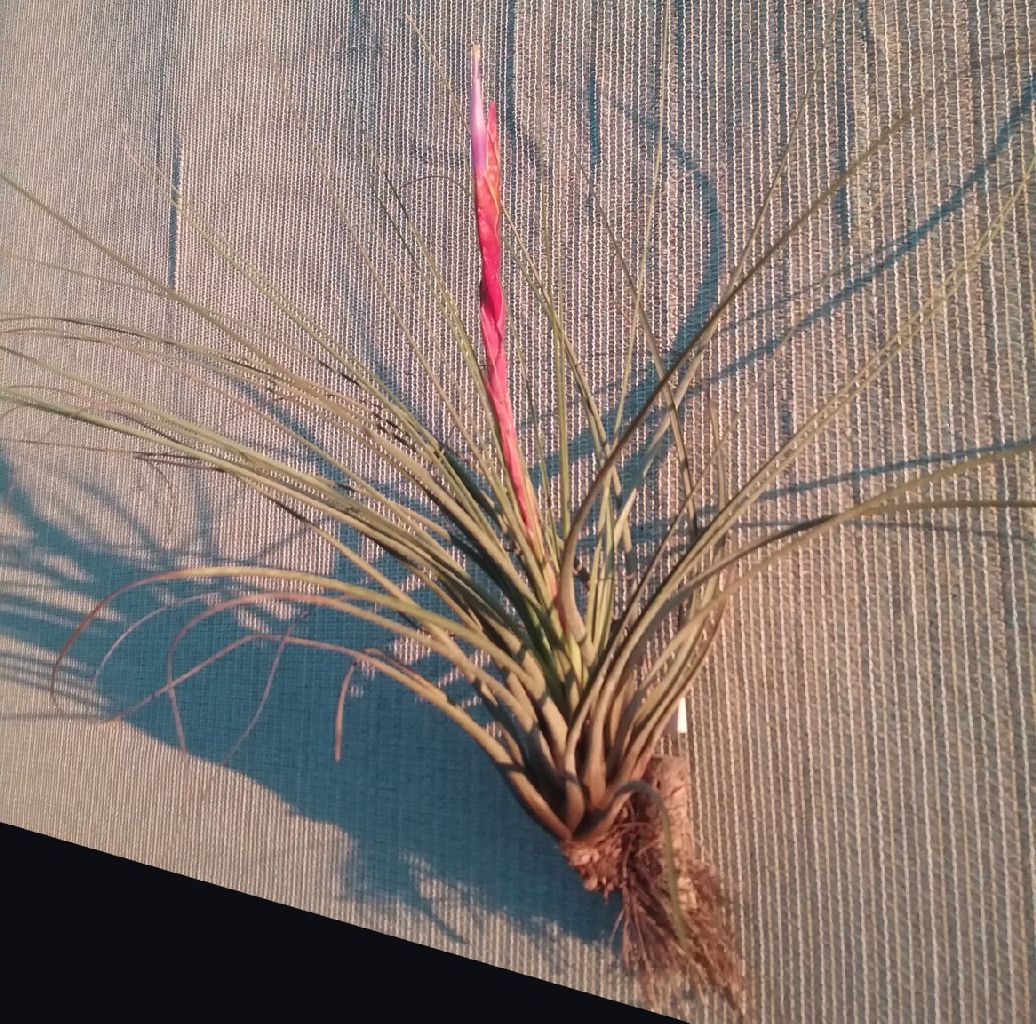
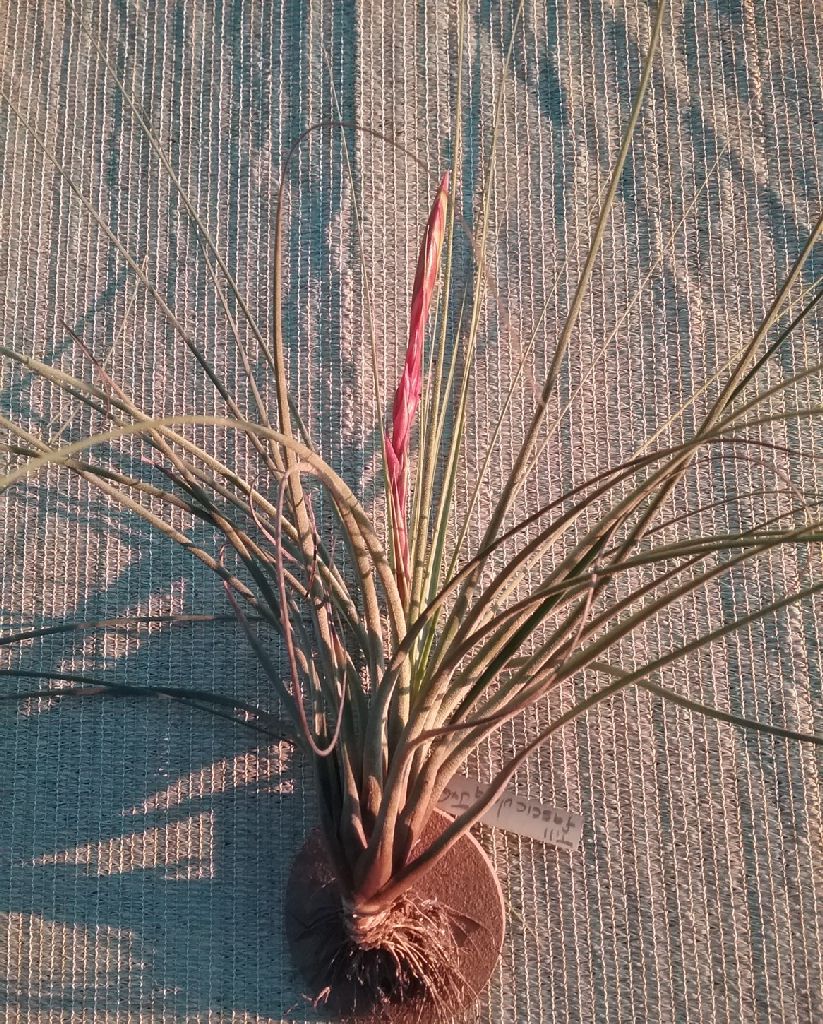
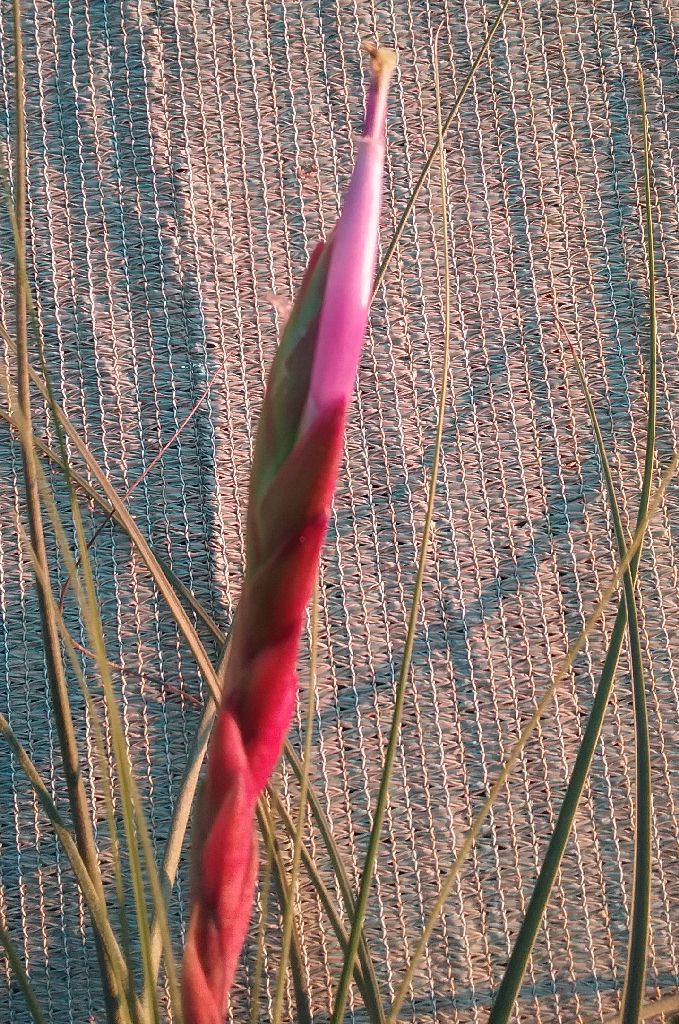
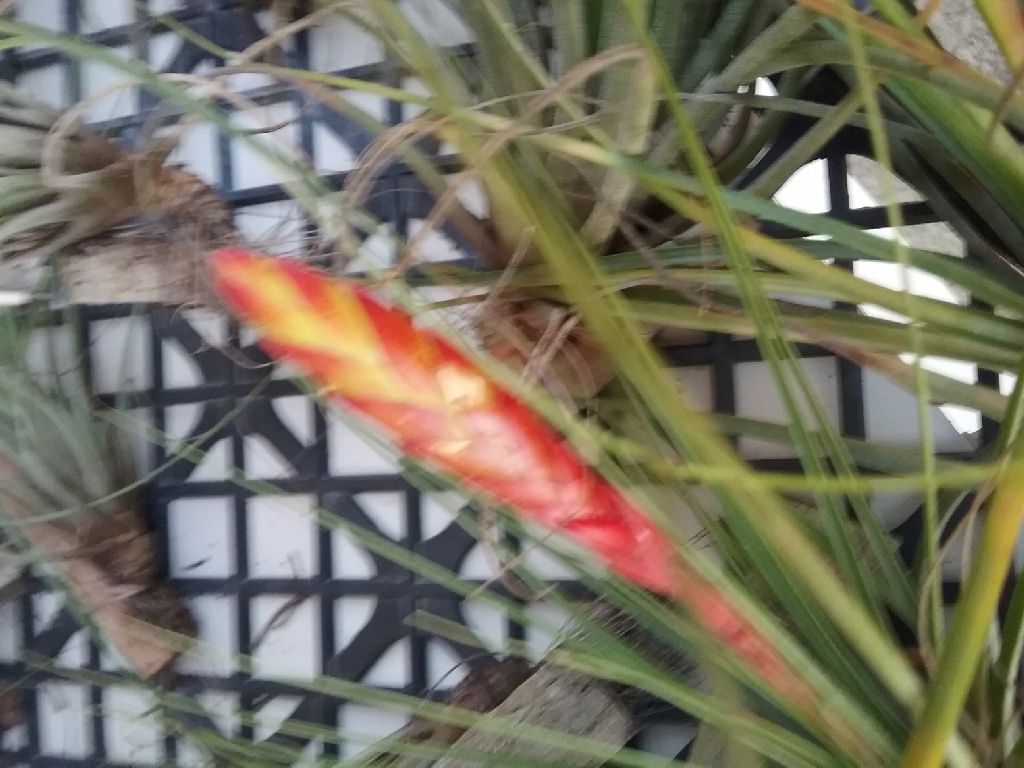
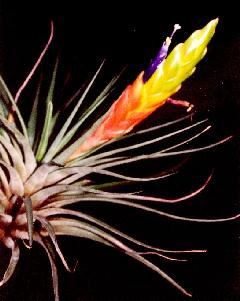
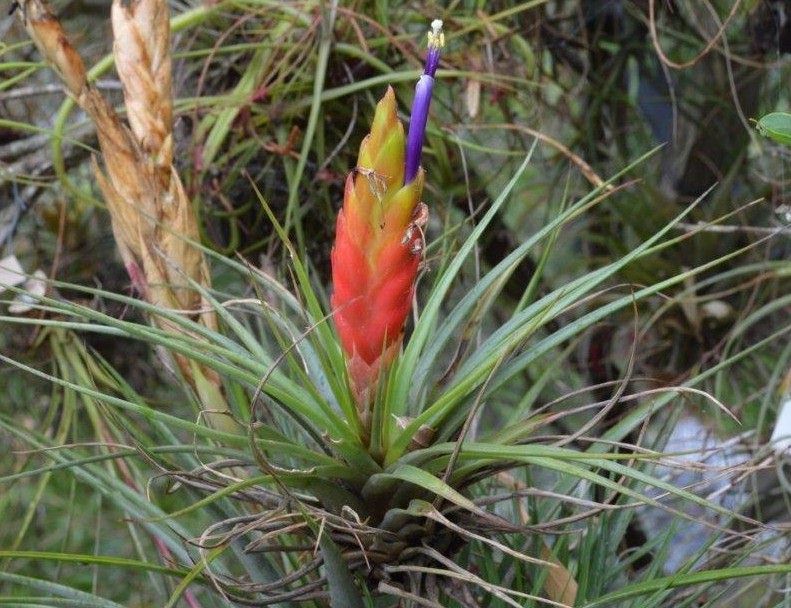
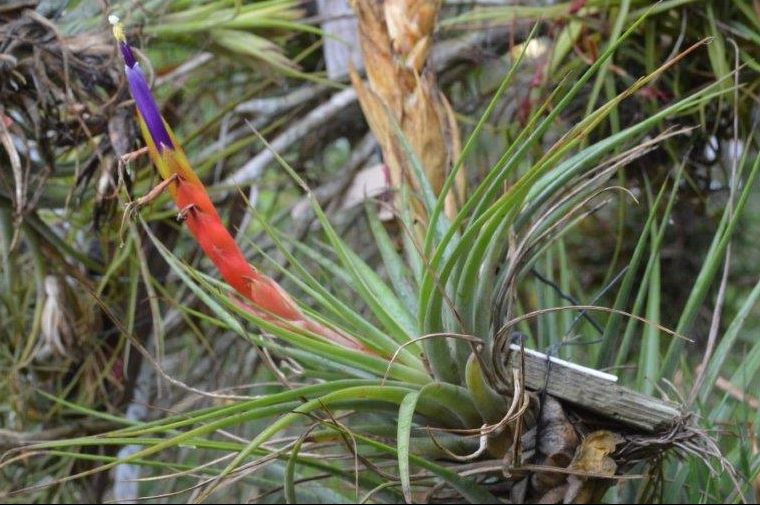
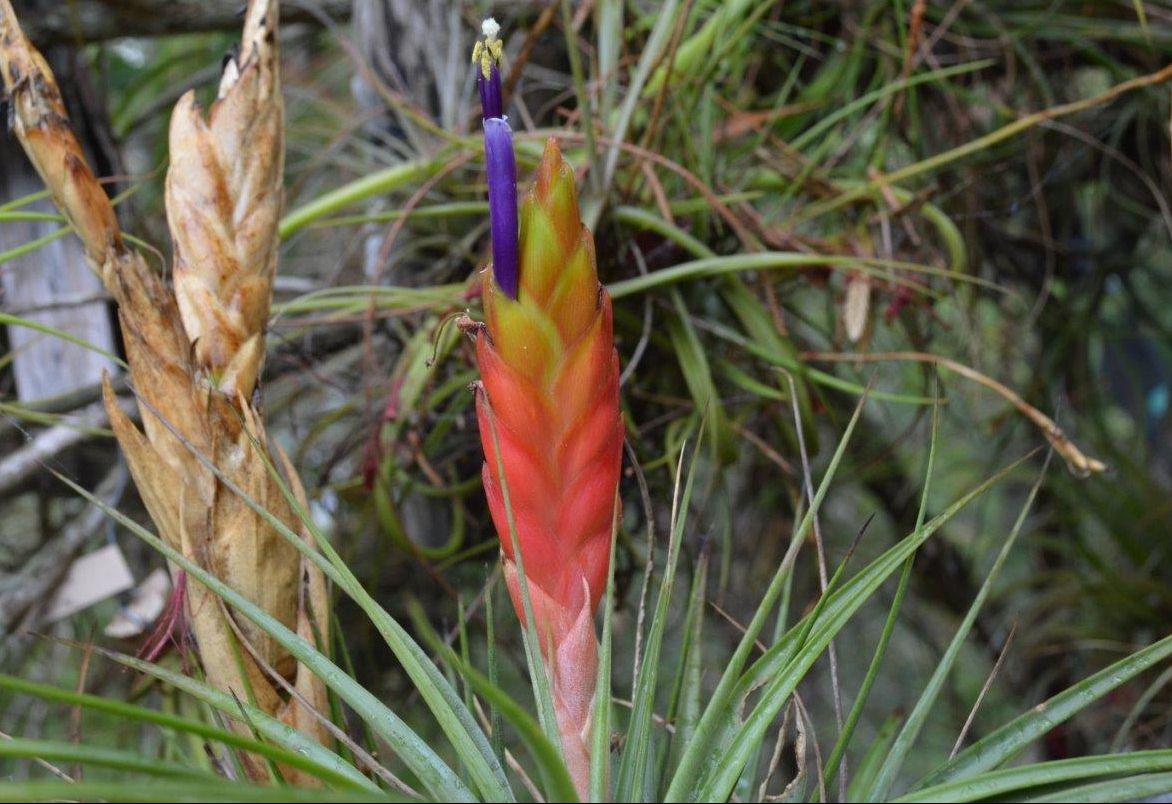
Tillandsia rhomboidea Andre, Enum. Bromel. 6. 13 Dec 1888; Revue Hort. 60: 566. 16 Dec 1888.
Synonym. Tillandsia acostae Mez & Tonduz ex Mez, Repert. Sp. Nov. 14: 252. 1916. see DeRebus II 1997 p112
Info from S&D p755 and p956
Detail below in brackets is from T. acostae description.
Plant stemless. (20-25 cm high)
Leaves stiff, 15-20 cm long, densely cinereous-lepidote; (many in a dense subspreading rosette, about equaling the inflorescence, rigid, very densely and minutely appressed-lepidote throughout)
Sheaths large, elliptic; (elliptic-oblong, 3-4 cm long, dark castaneous)
Blades narrowly triangular, involute-subulate, filiform-attenuate. (linear-triangular, 10-15 mm wide at the base, involute-subulate toward the apex, pungent).
Scape short but distinct, erect, stout; (erect, short and much obscured by the leaves, stout)
Scape-bracts imbricate, subfoliaceous. erect, (involute, densely imbricate, foliaceous, subinflated.)
Inflorescence simple, dense, 10-12 cm long, about equaling the leaves, slightly complanate with strongly convex sides; (simple or digitate from 2 subequal sessile spikes)
Rhachis not examined.
(Primary bracts like the upper scape-bracts but not laminate, scarcely longer than the floral bracts;)
(Spikes linear in outline, acuminate, terete, 7-14 cm long, 2 cm in diameter.)
(Flowers subsessile).
Floral bracts broadly rhombic, acute and apiculate, twice as long as the sepals, rose-purple, sparsely lepidote, the median nerve prominent. (distichous, erect, very densely imbricate, suborbicular, apiculate, 2 cm long, exceeding the sepals, inflated, carinate toward apex, coriaceous, even, glabrous;)
Sepals lanceolate, acute, 18 mm long, free anteriorly, completely connate posteriorly; (lanceolate, acute, 14 mm long, coriaceous, even, glabrous, carinate and much connate posteriorly)
Petals three times as long as the sepals, about equaling the stamens {this seems incorrect}, violet, their blades spreading to recurved, broadly obovate(tubular-erect, 35 mm long)
Stamens exserted for 10 mm.
TYPE. Andre 2745 in part (lectotype K, isotype NY), Piedra de Moler, banks of Rio de la Vieja, Cauca Valley near Cartago, Valle, Colombia, 15 Mar 1876.( Tonduz 17891 (holotype B, isotype US), Tremendal, San Ramon, Costa Rica, 13 May 1913)
DISTRIBUTION. Terrestrial, 900-1000 m alt, Valle, Colombia. COLOMBIA. VALLE: banks of Rio Bitaco, near Cali, Mar-Apr 1876, Andre 2745 in part (K, NY). {Epiphytic in rainforest, 750-1300 m alt, Mexico, Guatemala, Costa Rica. MEXICO. CHIAPAS: Ocozocoautla to Mal Paso, 17 Apr 1967, MacDougall 730 (US). GUATEMALA. JALAPA: Jalapa, Standley 76386 (F, GH). COSTA RICA. ALAJUELA: San Pedro de San Ramon, 29 Jul1935, Brenes 20573 (F); Villa Quesada, San Carlos, 14 Apr 1939,A. Smith F-1945 (F)}
Tillandsia rhomboidea Andre. Information in Selbyana 15(2) 1994
SPECIMENS EXAMINED. Aragua: Parque Nacional Henry Pittier, Rancho Grande, carretera a Ocumare de la Costa. vertiente norte. selva nublada, aprox. 10°19'N, 67°43'W. ca 1,100 m. December 1989, Carnevali & I. Ramirez 2824 (VEN). Falcon. Sierra de San Luis, alt. 1,200m, 11 Mayo 1973, Medina s/n(VEN);La Cumbre, en parte mas alta de carretera de Cienaga-Curimagua, alt. 1,200-1,400 m, 25 November 1971, Rutkis 257 (VEN). Tachira. Rio San Buena, 10 km East of La Fundacion, primary forested areas around Represa Dorada, forest evergreen, soils tending to be sandy derived from methamorphic rock (schist or gneiss), 700 - 1,000 m alt, 7°47-48'N, 71°46-47'W, 13-15 March 1980. Liesner, Gonzalez & Smith 9590 (VEN).
This species is frequently confused in herbaria with the more common Tillandsia fasciculata. Tillandsia rhomboidea is a smaller plant with less showy inflorescence. It also tends to occur at higher elevations than T. fasciculata, usually in humid or cloud forests, while T. fasciculata is more commonly a species of lower, drier localities.
Tillandsia rhomboidea ranges from Costa Rica to Venezuela. In Central America it has been known by the synonym T. acostae Mez & Tonduz. In Venezuela the species has been collected in the Sierra de San Luis and in Estado Tachira, both in the western sector of the country, and in Parque Nacional Henry Pittier, Estado Aragua, in the central section of the Coastal Range in northern Venezuela. We have also collected and cultivated plants of this species from Parque Nacional Guatopo, Estado Miranda, at 500-600 m.
287. Tillandsia acostae Mez & Tonduz ex Mez, Repert. Sp. Nov. 14: 252. 1916.
Desc from S&D
Plant stemless, 20-25 cm high.
Leaves many in a dense subspreading rosette, about equaling the inflorescence, rigid, very densely and minutely appressed-lepidote throughout;
sheaths elliptic-oblong, 3-1 cm long, dark castaneous;
blades linear-triangular, 10-15 mm wide at the base, involute-subulate toward the apex, pungent.
Scape erect, short and much obscured by the leaves, stout;
scape-bracts erect, involute, densely imbricate, foliaceous, subinflated.
Inflorescence simple or digitate from 2 subequal sessile spikes;
primary bracts like the upper scape-bracts but not laminate, scarcely longer than the floral bracts;
spikes linear in outline, acuminate, terete, 7-14 cm long, 2 cm in diameter.
Floral bracts distichous, erect, very densely imbricate, suborbicular, apiculate, 2 cm long, exceeding the sepals, inflated, carinate toward apex, coriaceous, even, glabrous;
flowers subsessile.
Sepals lanceolate, acute, 14 mm long, coriaceous, even, glabrous, carinate and much connate posteriorly;
petals tubular-erect, 35 mm long;
stamens exserted for 10 mm.
TYPE. Tonduz 17891 (holotype B, isotype US), Tremendal, San Ramon, Costa Rica, 13 May 1913.
DISTRIBUTION. Epiphytic in rainforest, 750-1300 m alt, Mexico, Guatemala, Costa Rica.
MEXICO. CHIAPAS: Ocozocoautla to Mal Paso, 17 Apr 1967, MacDougall 730 (US). GUATEMALA. JALAPA: Jalapa, Standley 76386 (F, GH). COSTA RICA. ALAJUELA; San Pedro de San Ramon, 29 Jul 1935, Brenes 20573 (F); Villa Quesada, San Carlos, 14 Apr 1939, A. Smith F-1945 (F).
From Mez 1935
29. T. Acostae Mez et Tonduz in Fedde, Repert. XIV. (1916) 252. –
Ad 0,2 m alta. Folia subbulbose rosulata, ad 0,18 m longa, medio vix 5 mm lata, in apicem subuliformi-acutissimum sensim angustata, sicca subulatim involuta, lepidibus pallidis appressis obtecta canescentia, rigidiuscula. Scapus foliis multo brevior, validus, erectus, dense vaginis inflatis, totis appresse lepidoto-canis, omnibus laminigeris indutus. Inflorescentia nunc simplex nunc digitatim e spicis 2 omnino aequalibus composita, pauci- vel subpauci-flora, folia aequans vel iis brevior; spicis plane sessilibus, usque ad 80 mm longis et 20mm Iatis, linearibus, ad 12-floris, e bracteis inflatis praeclare tumidis; bracteis florigeris quam maxime convexis spicas fere teretes reddentibus, densissime imbricatis, rigidiusculis, glabris, apicem versus prominulo-venosis, Iatissime breviterque subacuminatim aeutis, in parte superiore bene carinatis, sepala optime superantibus. Flores stricte erecti, filamentis computatis ad 45 mm longi; sepalis antico libero posticis ultra medium connatis, coriaceis, glabris, laevibus, 10 mm longis, acutiusculis. Petala 35 mm longa, tubulose erecta, quam stamina 10 mm breviora.
Costarica: San Ramon, Walder der Hugel bei Tremendal (Tonduz in Herb. inst, phys.-geogr. Costaric. n. 17891).
284. T. rhomboidea Andre in Rev. Hortic. LX (1888) 566 et Bromel. Andr. (1889) 75, t. 20. –
Ad 0,2 m alta. Folia subbulbose rosulata, 0,15-0,2 m longa, tota longitudine fistulose involuta subulata, sensim acutissima, cinereo-lepidotissima. Scapus erectus, robustus, foliis brevior, dense vaginis omnino foliaceis, internodia longe superantibus indutus. Inflorescentia simplicissima, dense disticha, flabellata, recta vel leviter incurva, parum complanata utraque facie perinsigniter convexa, ad 16-flora, folia aequans, 0,1 ad 0,12 m longa; rhachi haud excavata; bracteis latis, rhomboideo-acutis, breviter mucronatis, nervo dorsali bene prominente, sparse lepidotis, sepala duplo superantibus. Flores erecti; sepalis antico libero, posticis binis apicem usque connatis, lanceolato-acutis. Petala sepalis triplo longiora, violacea, stamina superantia; laminis late obovatis, patenti-recurvis.
Colombia: am Rio Bitaco bei Cali und im Cauca-Tal am Rio de la Vieja bei Piedra de Moler (Andre n. 2745).